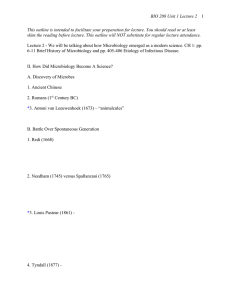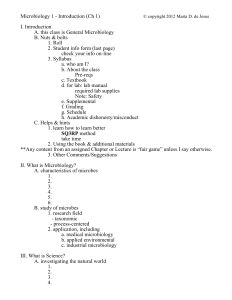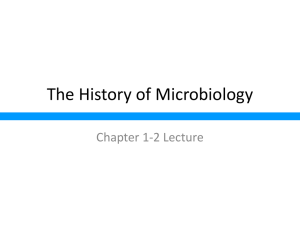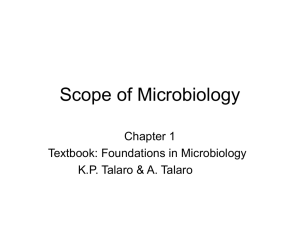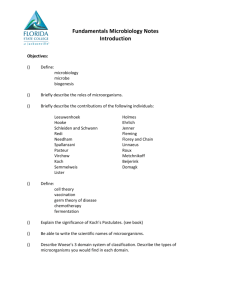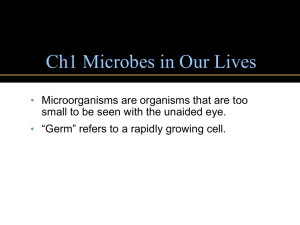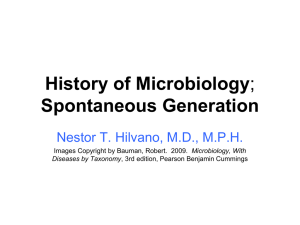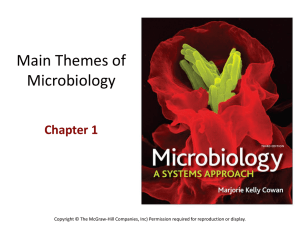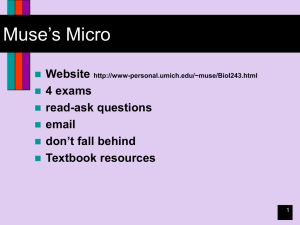Micro01_Intro
advertisement
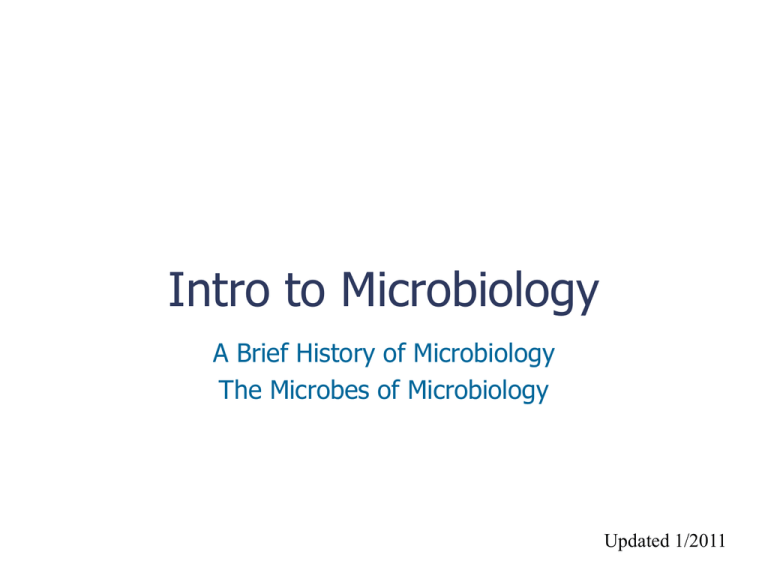
Intro to Microbiology A Brief History of Microbiology The Microbes of Microbiology Updated 1/2011 What is Microbiology? Why should we study Microbiology? Why should we study Micro? Help protect us from pathogens by taking up space and activating our immune system. Make us healthy by producing vitamins. Can be used to produce food, medicines, and more. Microbes form the base 10X more bacteria Help of the food chain. than our own cells plants http://www.tutorvista.com/science/pictures-of-food-webs absorb nutrients and grow faster http://www.cof.orst.edu/cof/teach/for442/cinfof.htm Conclusion: Understanding microbes is vital for other study of life! Advances in microbiology have followed advances in technology And vice-versa… The Early Years of Microbiology Anton van Leeuwenhoek (Dutch) Began making and looking through simple microscopes Examined water, semen, teeth scrapings ~1683 Visualized tiny animals, fungi, algae, and single celled protozoa; “animalcules” By end of 19th century, these organisms were called microorganisms http://www.history-of-the-microscope.org/anton-van-leeuwenhoek-microscope-history.php The Golden Age of Microbiology Scientists searched for answers to four questions Is spontaneous generation of microbial life possible? What causes fermentation? What causes disease? How can we prevent infection and disease? Is Spontaneous Generation of Microbial Life Possible? Aristotle proposed spontaneous generation living things can arise from nonliving matter Explained many observations Theory came under challenge in 17th century Redi’s Experiments (late 1600s) Needham’s Experiments (mid 1700s) Spallanzani’s Experiments (1799) Pasteur’s Experiments (mid 1800s) Redi’s Experiments Meat exposed to flies developed maggots, when meat is kept isolated maggots do not develop Conclusion: Animals only come from other animals. After Leeuwenhoek discovered microbes scientists assumed that microbes arose spontaneously Thought they were too small/simplistic to reproduce Incorrect conclusions misled scientists. The Scientific Method Debate over spontaneous generation led in part to development of scientific method Observations lead a scientist to ask questions about some phenomenon The scientist generates hypothesis (potential answer to question) The scientist designs and conducts experiment to test hypothesis Based on observed results of experiment, scientist either accepts, rejects, or modifies hypothesis Louis Pasteur Performed a similar experiment to Spallanzani Instead of completely sealing his flasks he bent the necks which allowed air to enter but prevents contamination Flasks remained pure until they were exposed to dust Conclusion: Microbes in the flask are the progeny of microbes on the dust Pasteur also researched Fermentation and Infection Cell Theory Pasteur’s evidence and conclusions led to the cell theory. The cell is the fundamental unit of Life. All organisms are made of cells. All cells come from previously existing cells. What Causes Disease? Pasteur developed germ theory of disease Microbes are responsible for disease Robert Koch studied causative agents of disease Anthrax Examined colonies of microorganisms Developed Koch’s Postulates Koch’s Postulates 1. Suspected causative agent must be found in every case of the disease and be absent from healthy hosts(a) 2. Agent must be isolated and grown outside the host(b). 3. When agent is introduced into a healthy(c), susceptible host, the host must get the disease(d). 4. Same agent must be re-isolated from diseased experimental host(e,f) http://media.wiley.com/Lux/26/8326.nfg002.jpg Laboratory Microbiology Advances by Koch and Others Simple staining techniques First photomicrograph of bacteria First photomicrograph of bacteria in diseased tissue Techniques for estimating CFU/ml Use of steam to sterilize media Use of Petri dishes Aseptic techniques Bacteria as distinct species How Can We Prevent Infection and Disease? Semmelweis and handwashing Lister’s antiseptic technique Nightingale and nursing Snow and epidemiology – infection control and epidemiology Jenner’s vaccine – field of immunology Ehrlich’s “magic bullets” – field of chemotherapy The Modern Age of Microbiology What are the basic chemical reactions of life? Biochemistry How do genes work? Microbial genetics, Molecular biology, Recombinant DNA technology, Gene therapy What role do microorganisms play in the environment? Environmental microbiology How do we defend against disease? Serology, Immunology, Chemotherapy Meet the Microbes! Microorganisms we will study: Fungi, Protozoa, Algae, Bacteria, Archaea, certain Animals Non-living particles are also included: Viruses, virons, prions No plants! Fungi Eukaryotic (have membrane-bound nucleus) Obtain food from other organisms Possess cell walls of chitin Examples: Molds – multicellular; have hyphae; reproduce by sexual and asexual spores Yeasts – unicellular; reproduce asexually by budding; some produce sexual spores [Mushrooms – not discussed in Microbiology] Protozoa (Protist) Single-celled eukaryotes Similar to animals in their nutritional needs and cellular structure Most reproduce asexually; some sexually Sometimes classified by type of movement Pseudopods Cilia Flagella Algae (Protist) Unicellular or multicellular Photosynthetic Categorized by: Pigmentation storage products cell wall composition Bacteria and Archaea Unicellular and lack nuclei Much smaller than eukaryotes Found everywhere there is sufficient moisture; some found in extreme environments Use every type of metabolism Reproduce asexually Two Groups of Prokaryotes Bacteria Cell walls contain peptidoglycan (some lack cell walls) most do not cause disease and some are beneficial Archaea cell walls composed of polymers other than peptidoglycan Some live in extreme environments, none identified that cause disease Methanopyrus kandleri Copyright K.O.Stetter and R.Rachel, Univ. Regensburg, Germany Other Microbes of Importance Animals Eukaryotic, multicellular, heterotrophs Parasites or vectors for other diseases Viruses Non-cellular infectious particles DNA or RNA in a protein coat http://health.enotes.com/images/neurolo gical-disorders/gend_02_img0088.jpg Viroids Smaller than viruses RNA without protein or protein genes Prions Infectious proteins http://universe-review.ca/I11-45-viroid.jpg
